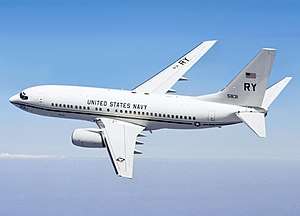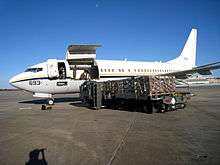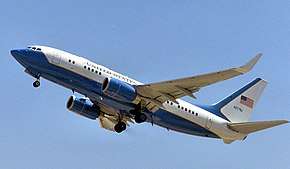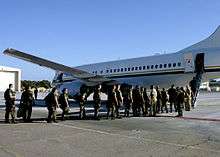Boeing C-40 Clipper
The Boeing C-40 Clipper is a military version of the Boeing 737-700C airline transport. It is used by both the United States Navy and the United States Air Force, and has been ordered by the United States Marine Corps.[2] The Navy C-40A variant is named "Clipper", whereas the USAF C-40B/C variants are officially unnamed.
| C-40 Clipper | |
|---|---|
 | |
| A C-40 of squadron VR-59 | |
| Role | Military transport aircraft |
| National origin | United States |
| Manufacturer | Boeing |
| First flight | April 2000[1] |
| Introduction | 21 April 2001 |
| Status | Active service |
| Primary users | United States Navy United States Air Force |
| Produced | 2001–2019 |
| Number built | 28 |
| Unit cost |
US$70 million |
| Developed from | Boeing 737 Next Generation |
Design and development
The C-40 combines the Boeing 737-700 fuselage with the strengthened wings and landing gear of the larger and heavier 737-800. It also has auxiliary fuel tanks allowing an unrefuelled range of up to 5,000 nmi (9,300 km; 5,800 mi) compared with 3,010 nmi (5,570 km; 3,460 mi) for the standard 737-700.[3]
C-40A
The C-40A Clipper provides critical logistics support to the United States Navy. Its flight deck features a flight management computer system with an integrated GPS, and is compatible with future GATM/FANS operating environment (RNP-1). It is outfitted with the Traffic Alert and Collision Avoidance System II, and is RVSM-capable. It also has an enhanced ground proximity warning system, predictive wind shear, head-up display and TACAN/UHF/IFF functions.
First flight took place in April 2000 and the first of the C-40A aircraft entered service in April 2001.[4]

The U.S. Navy Reserve was the first customer for the newest member of the Boeing 737-700C Next-Generation family.[5][6] The Clipper was ordered by the U.S. Navy to replace its fleet of aging C-9B Skytrain IIs. The C-40A is the first new logistics aircraft in 17 years to join the U.S. Navy Reserve. The Navy Reserve provides all of the Navy's medium and heavy airlift capabilities.[4] The Clipper meets or exceeds international noise and environmental requirements, which the fleet of Naval Reserve C-9s did not. It is also more fuel-efficient and offers increased range and payload capabilities. The Clipper is certified to operate in an all-passenger (121 passengers), all-cargo or combination ("combi") configuration that can accommodate up to three cargo pallets and 70 passengers on the main deck.[7]
The Navy purchased the airplanes using standard commercial practices, ordering six of the 737-700C models . The first two of four aircraft were delivered on 21 April 2001 to Fleet Logistics Support Squadron Five Nine (VR-59) at the Naval Air Station/Joint Reserve Base Fort Worth, Texas, with two more aircraft following before the end of the year. The fifth and sixth aircraft were delivered in August 2002 to VR-58 at the Naval Air Station Jacksonville, Florida. Further aircraft have been delivered to VR-57 at the Naval Air Station North Island, California. The C-40A provides superior fuel efficiency, range and payload compared to the C-9B aircraft it placed.[5]
In the 2018 Marine Aviation Plan, the U.S. Marine Corps indicated that it intended to acquire two C-40A aircraft for airlift missions, replacing its Skytrain fleet.[8] On 4 December 2018 an online notice was posted by the Marines seeking a supplier of C-40s to be delivered in 2020.[2] The USMC Skytrains were retired in 2017 and to prepare for the transition to new aircraft, personnel from Marine Transport Squadron One were assigned to operate Navy Clippers until the arrival of their own aircraft.[9]
C-40B

The United States Air Force selected the C-40B, a military version of the 737-700 Boeing Business Jet, to replace the aging fleet of C-137 aircraft for U.S. combatant commanders. The Air Force awarded the medium lift contract in August 2000. The 89th Airlift Wing acquired its first C-40B aircraft in December 2002. Both units are based at Andrews Air Force Base, Maryland. The 15th Airlift Wing, Hickam AFB, Hawaii, acquired its C-40B for U.S. Pacific Command in February 2003. The 86th Airlift Wing, Ramstein AB, Germany, acquired its C-40B for U.S. Air Forces in Europe in December 2004.[3]
The cabin area is equipped with a crew rest area, distinguished visitor compartment with sleep accommodations, two galleys and business class seating with worktables.[3]
The C-40B is designed to be an "office in the sky" for senior military and government leaders. The aircraft features two-way broadband data communications, including secure voice and data communication; elements include internet and network access, telephones, satellites, facsimile and copy machines. The C-40B also has a computer-based passenger data system.[3]
C-40C
The C-40C is not equipped with the advanced communications capability of the C-40B. Unique to the C-40C is the capability to change its configuration to accommodate from 42 to 111 passengers.[3] The C-40C replaced three C-22s (a militarized Boeing 727) operated by the Air National Guard and National Guard Bureau to airlift personnel. The C-40C was the first military aircraft to be acquired in this as an off-the-shelf aircraft for the Department of Defense. The 201st Airlift Squadron, District of Columbia Air National Guard acquired two C-40C aircraft in October 2002. The Air Force Reserve 932d Airlift Wing, Scott AFB, Illinois acquired three C-40C aircraft in 2007.[3]
Variants

- C-40A Clipper
- United States Navy version of the Boeing 737-700 for high-priority cargo and passenger transport, seventeen built.[10]
- C-40B
- United States Air Force version of the Boeing 737-700 based Boeing Business Jet modified as a special mission aircraft for commanders and government officials, four built.
- C-40C
- United States Air Force version of the Boeing 737-700 based Boeing Business Jet, operational support and transport aircraft, seven built.
Operators
- United States Air Force[11][12][13][14]
- 15th Wing – Hickam AFB, Hawaii
- 86th Airlift Wing – Ramstein AB, Germany
- 89th Airlift Wing – Andrews AFB, Maryland
- 113th Wing – Andrews AFB, Maryland
- 375th Air Mobility Wing – Scott AFB, Illinois
- 54th Airlift Squadron
- 932d Airlift Wing – Scott AFB, Illinois
- 73d Airlift Squadron
- United States Navy
- VR-56 – NAS Oceana, Virginia
- VR-57 – NAS North Island, California
- VR-58 – NAS Jacksonville, Florida
- VR-59 – Naval Air Station Joint Reserve Base Fort Worth, Texas
- VR-61 – NAS Whidbey Island, Washington
- United States Marine Corps
Specifications (C-40A)
.jpg)
Data from
General characteristics
- Crew: 6 (two pilots, one 'crew chief', one 'loadmaster' and two 'second loadmasters')[note 1]
- Capacity:
- Passenger configuration: 121 passengers
- Cargo configuration: 8 pallets of cargo
- Combination configuration: 3 pallets of cargo, 70 passengers.
- Payload 40,000 lb (18,144 kg)
- Airfoil: root: BAC 449/450/451 ; tip: BAC 442 mod[15]
Performance
- Thrust/weight: 0.407 lbf/lb (0.00399 kN/kg)
- only one 'second loadmaster' required when carrying under 100 passengers. no 'second loadmasters' are required when carrying only cargo.
See also
Related development
- Boeing 737 – Single aisle airliner family by Boeing
- Boeing 737 AEW&C – Airborne early warning and control aircraft
- Boeing P-8 Poseidon – Maritime patrol aircraft derived from 737-800
- Boeing T-43 – US Air Force aircraft used for navigator training, derived from 737-200
- Boeing Business Jet – Executive transport variants of several Boeing airliners
- Military transport aircraft
Related lists
References
- https://www.naval-technology.com/projects/clipper/
- Reim, Garrett (5 December 2018). "US Marine Corps looks to buy two C-40 executive transports". FlightGlobal. Archived from the original on 25 April 2019. Retrieved 29 May 2019 – via Flightglobal.com.
- "C-40B/C > U.S. Air Force > Fact Sheet Display". af.mil. US Air Force. 4 June 2003. Archived from the original on 17 September 2013. Retrieved 4 June 2003.
- "C-40A Clipper". Naval Technology. Retrieved 19 January 2020.
- "Boeing Delivers Ninth C-40A Aircraft to U. S. Navy". Boeing. 5 June 2006. Archived from the original on 29 May 2019. Retrieved 29 May 2019 – via boeing.mediaroom.com.
- "Boeing: C-40 Clipper". www.boeing.com. Archived from the original on 15 March 2016. Retrieved 21 March 2016.
- "C-40A Product Card" (PDF). www.boeing.com. Boeing. 11 March 2016. Archived (PDF) from the original on 1 April 2016. Retrieved 29 May 2019.
- 2018 Marine Aviation Plan (PDF). www.aviation.marines.mil. US Marine Corps. 14 December 2017. p. 100. Retrieved 29 May 2019.
- Burgess, Richard R. (26 May 2017). "Marines to Fly Navy C-40 Transports While Awaiting their Own". Seapower Magazine. Archived from the original on 16 December 2012. Retrieved 29 May 2019 – via seapowermagazine.org.
- "Boeing: C-40 Clipper". Boeing.com. Boeing. Archived from the original on 17 April 2019. Retrieved 29 May 2019.
- "65 Airlift Squadron (PACAF) > Air Force Historical Research Agency > Display". af.mil. US Air Force. Archived from the original on 29 May 2019. Retrieved 29 May 2019.
- "76 Airlift Squadron (USAFE) > Air Force Historical Research Agency > Display". af.mil. US Air Force. Archived from the original on 29 May 2019. Retrieved 29 May 2019.
- "1 Airlift Squadron (AMC) > Air Force Historical Research Agency > Display". af.mil. US Air Force. Archived from the original on 29 May 2019. Retrieved 29 May 2019.
- Kelly-Herard, Amber R. (24 August 2010). "Scott squadron flies important passengers around the world". af.mil. US Air Force. Archived from the original on 29 May 2019. Retrieved 29 May 2019.
- Lednicer, David. "The Incomplete Guide to Airfoil Usage". m-selig.ae.illinois.edu. Archived from the original on 26 March 2019. Retrieved 16 April 2019.
External links
| Wikimedia Commons has media related to Boeing C-40 Clipper. |